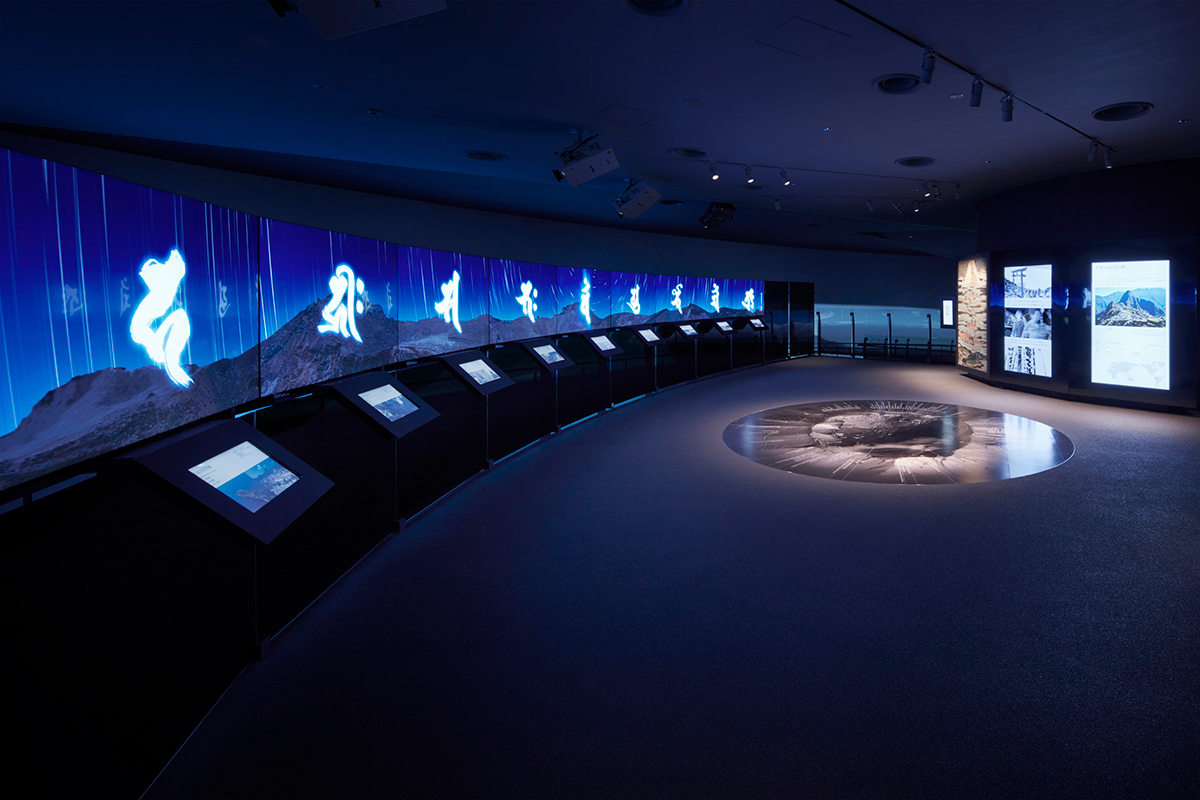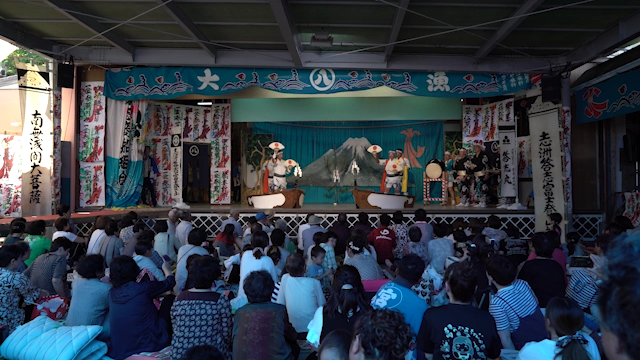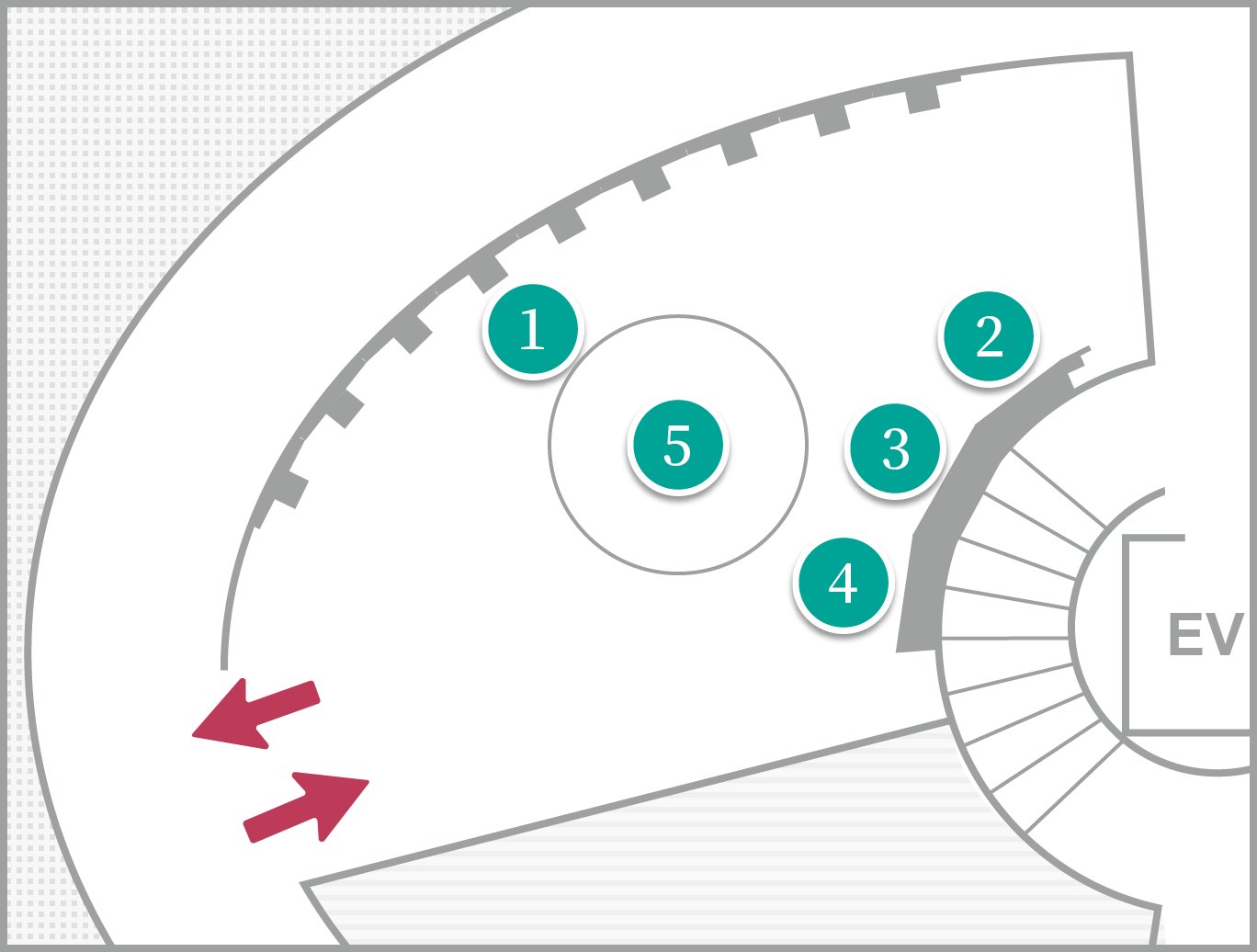

Sacred Mountain
With its repeated volcanic activity since ancient times, Mt. Fuji became the object of yohai, in which the summit is looked up to and worshipped from the mountain base. The increase of volcanic act....
Mt. Fuji tohai and Ohachi-Meguri experience
Song of pilgrimage to Mt. Fuji

Photography location: Toushijima, Toba City, Mie Prefecture (Jinji-no-Butai); photographed June 2, 2018
Michiyukiuta is a song of pilgrimage to Mt. Fuji sung while climbing Mt. Fuji, with l....

The Hachiyō Kuson Multi-monitor expresses the religious world at the summit, which is the main area for worshipping Mt. Fuji, the "sacred mountain." The daily cycle at the summit, which starts with sunrise and the Buddhas who float to the summit known as "hachiyō" (the eight-petalled lotus) around Mahavairocana, who is enshrined in the crater. In the past, the peak was known as zenjō (or meditative concentration), and was perceived of as a world of mandalas in which the Hachiyō Kuson Buddha is enshrined.

Since ancient times, people in the Japanese archipelago have found divine spirits in nature, prayed to them, and lived together with them.
Mt. Fuji erupted repeatedly from ancient times and it became an object of worship as people looked up to the summit from the foot of the mountain in a form of observance known as 'veneration from afar' (yōhai).
With the arrival of Buddhism in Japan, beliefs in the syncretism of native deities (kami) and Buddhas became popular. The relationship between native deities and Buddhas and bodhisattvas became inextricably linked in Japan. Later, the presence of both deities and Buddhas on Mt. Fuji raised Fuji to the status of a famous sacred mountain.
As its eruption activity subsided, religious people known as mountain ascetics made Mt. Fuji a place for shugendō mountain ascetic practices. These ascetics played a role in expanding Mt. Fuji worship throughout Japan.
As worship of the sacred mountain Mt. Fuji spread, many pilgrims (or dōsha) visited from various places and made worship-ascents (called tohai) for zenjō, or ascetic practices at the summit. Here we will introduce the climbing trails to the pilgrims' destination: the summit of Mt. Fuji.
The Hachiyō Kuson Multi-Monitor shows the worldview of the summit of Mt. Fuji, the destination of pilgrims (dōsha) who make worship-ascents (tohai) of Fuji. The summit is called zenjō and is considered to be a world like a Buddhist mandala, where various Buddhas of the Hachiyō Kuson (Buddhas and bodhisattvas on the eight-petalled lotus) are seated.
Worship of Mt. Fuji originates in worship of the summit, where the deities and Buddhas of the mountain reside.
Between the 16th and 17th centuries, when Japan was moving from the Middle Ages to the early modern period, new beliefs were born around the sacred mountain of Mt. Fuji. These beliefs blossomed into the Fuji-kō associations which worshipped Mt. Fuji and spread explosively, mainly in the Kantō region.
Folk ceremonies based on worship of Mt. Fuji still remain in many parts of Japan and have been passed down from one generation to another.
This work from the 16th century, with the vessel-shaped red seal of Kanō Motonobu in the lower right corner of the painting, depicts the view from the Omote-guchi entrance to Mt. Fuji. In the lower part of the picture are Seiken-ji Temple, Suruga Bay, and the Miho-no-Matsubara pine tree grove, and the summit of Mt. Fuji is rendered with three ridges, which is a stylized composition common in la....
Even today, there are people all over Japan who worship Mt. Fuji and communicate their faith in the mountain. This area introduces important examples of this devotion. These include the Miyamoto Fuji-kō from the Higashi-toyohama-cho Doro district, in Ise City, Mie Prefecture, ascetic ablutions in Agochoshijima district, Shima City, Mie Prefecture, and the Torii-kō from the Iwabuchi district of ....
For humankind, mountains are sites where a power beyond humans is hidden, and they inspire awe and worship as places leading to another world. Here we will introduce some examples of sacred mountains from around the world.
Processing around the approximately 3-kilometer crater circumference at the summit of Mt. Fuji in a clockwise direction is known as ohachi-meguri. It is thought that this name came about because the crater is shaped like a mortar, or suribachi. However, it was originally derived f....